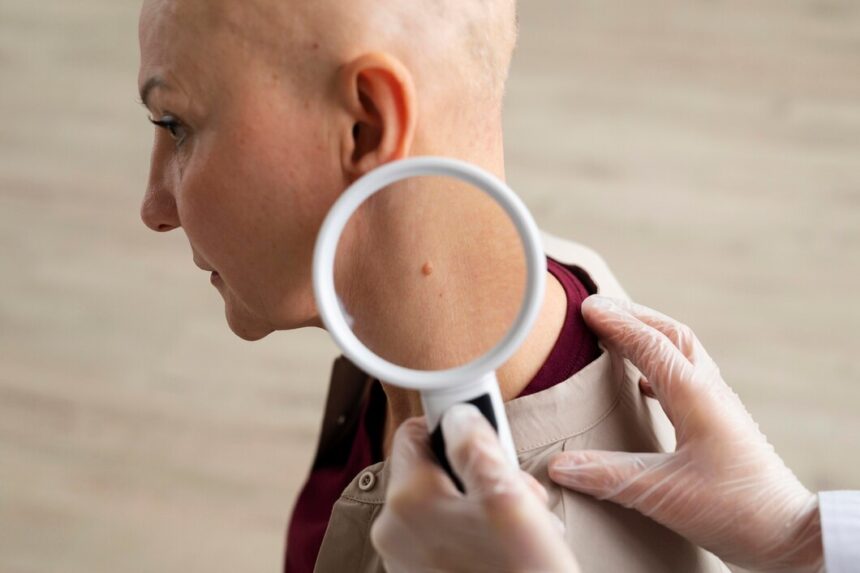Skin cancer is one of the most common types of cancer, with millions of cases diagnosed each year worldwide. Early detection is crucial for successful treatment and better outcomes. Understanding the early signs and symptoms of skin cancer can help individuals identify potential issues and seek medical attention promptly. This article outlines the key indicators to watch for.
Types of Skin Cancer
There are three main types of skin cancer:
- Basal Cell Carcinoma (BCC): The most common and least aggressive form, often appearing on sun-exposed areas.
- Squamous Cell Carcinoma (SCC): More aggressive than BCC, can also develop on sun-exposed areas and has a higher tendency to spread.
- Melanoma: The most dangerous form, can develop anywhere on the body and is more likely to spread to other parts of the body.
Early Signs and Symptoms
1. New Growths or Sores that Don’t Heal
- Persistent Sores: A sore that does not heal within a few weeks should be examined by a healthcare professional.
- New Growths: Any new skin growth or spot, especially if it looks different from other moles or spots, warrants attention.
2. Changes in Existing Moles or Spots
- Asymmetry: One half of the mole does not match the other half.
- Border: The edges are irregular, ragged, notched, or blurred.
- Color: There is a variety of colors within the mole, including shades of brown, black, tan, red, white, or blue.
- Diameter: The mole is larger than 6 millimeters (about the size of a pencil eraser), although melanomas can sometimes be smaller.
- Evolving: The mole is changing in size, shape, or color over time.
These characteristics are summarized by the acronym ABCDE (Asymmetry, Border, Color, Diameter, Evolving).
3. Unusual Skin Changes
- Redness or New Swelling: Beyond the border of a mole.
- Itchiness or Pain: Moles or spots that become itchy, tender, or painful.
- Changes in Sensation: Such as itching, tenderness, or pain.
4. Skin Lesions
- Shiny Bumps: Flesh-colored, pearly, or waxy bumps, which may be indicative of basal cell carcinoma.
- Scaly Patches: Rough, scaly red patches that may crust or bleed, often associated with squamous cell carcinoma.
- Flat, Flesh-Colored Lesions: Brown scar-like lesions that might indicate basal cell carcinoma.
Risk Factors
Understanding the risk factors can help in early detection:
- Excessive Sun Exposure: UV radiation from the sun or tanning beds.
- Fair Skin: Individuals with lighter skin, hair, and eye color.
- History of Sunburns: Especially blistering sunburns in childhood.
- Family History: A family history of skin cancer increases the risk.
- Personal History: Previous skin cancer or precancerous lesions.
- Weakened Immune System: Individuals with compromised immune systems are at higher risk.
Prevention Tips
While it’s crucial to recognize the signs of skin cancer, prevention is equally important:
- Use Sunscreen: Apply broad-spectrum sunscreen with an SPF of 30 or higher.
- Avoid Tanning Beds: UV light from tanning beds increases the risk of skin cancer.
- Wear Protective Clothing: Hats, sunglasses, and long-sleeved clothing can provide protection.
- Seek Shade: Especially during peak sun hours (10 AM to 4 PM).
- Regular Skin Checks: Perform self-examinations monthly and schedule annual check-ups with a dermatologist.
When to Seek Medical Attention
If you notice any of the early signs and symptoms of skin cancer, it is important to consult a healthcare professional immediately. Dermatologists can perform thorough skin examinations and may conduct biopsies of suspicious lesions to determine if they are cancerous.
Early detection of skin cancer significantly improves the chances of successful treatment and survival. By being vigilant about changes in your skin and understanding the early signs and symptoms, you can take proactive steps to safeguard your health. Regular skin checks, protective measures against UV exposure, and prompt medical consultations are key components in the fight against skin cancer.










